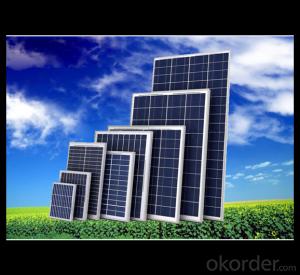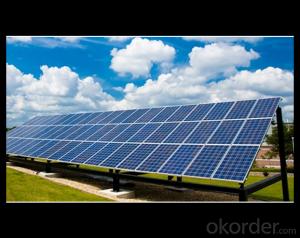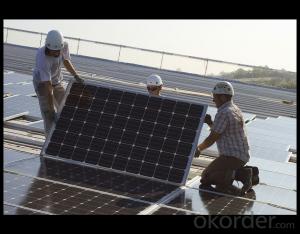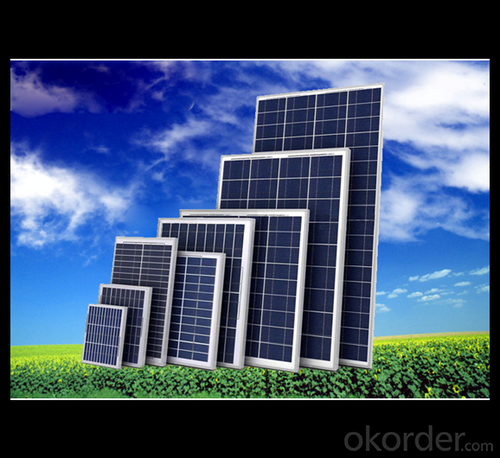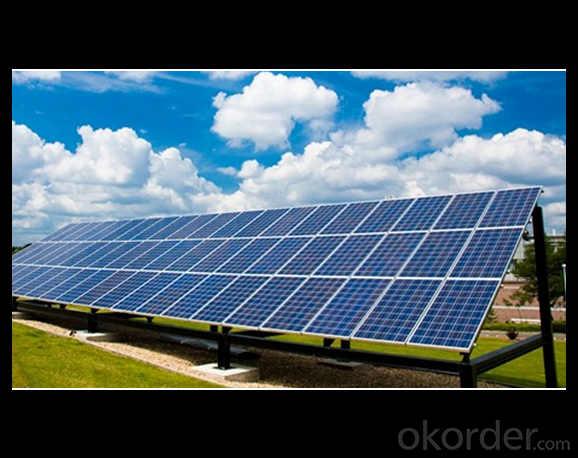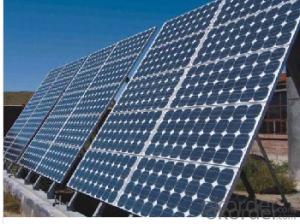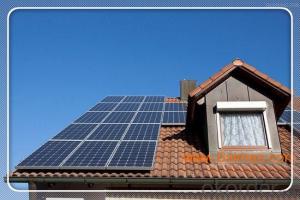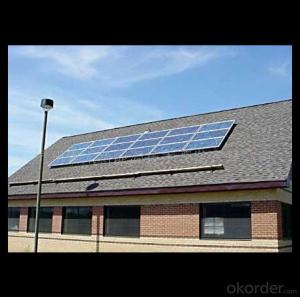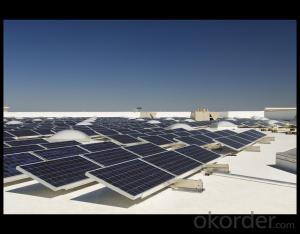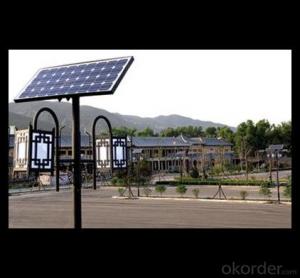Dometic Solar Panels 20w Direct Factory Sale Price 260-300watt
- Loading Port:
- China main port
- Payment Terms:
- TT OR LC
- Min Order Qty:
- 10000 watt
- Supply Capability:
- 100000 watt/month
OKorder Service Pledge
OKorder Financial Service
You Might Also Like
Specification
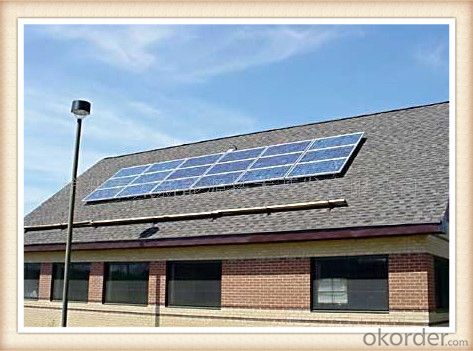
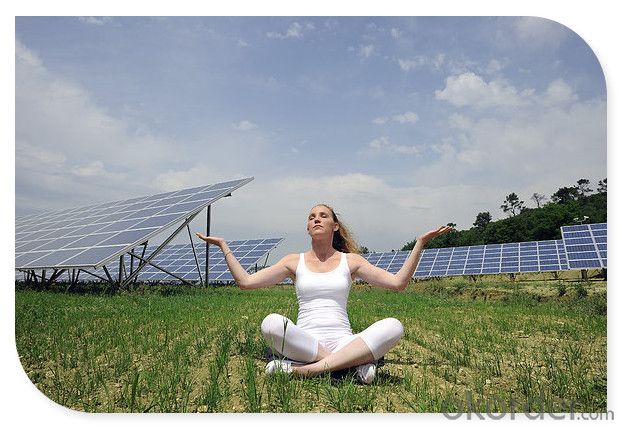
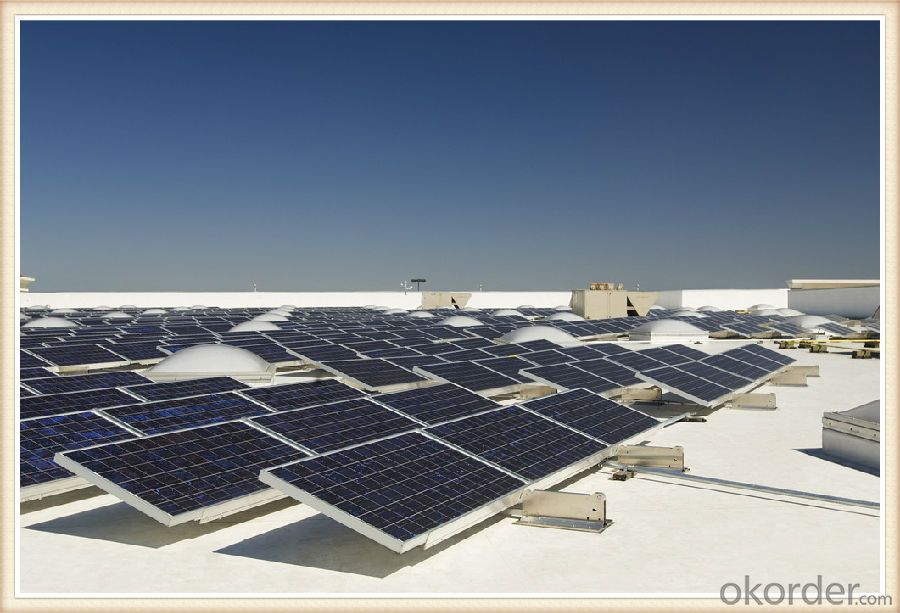
Solar Module Introduction
Solar modules use light energy (photons) from the sun to generate electricity through the photovoltaic effect. The majority of modules use wafer-based crystalline silicon cells or thin-film cells based on cadmium telluride or silicon. The structural (load carrying) member of a module can either be the top layer or the back layer. Cells must also be protected from mechanical damage and moisture. Most solar modules are rigid, but semi-flexible ones are available, based on thin-film cells. These early solar modules were first used in space in 1958.
Electrical connections are made in series to achieve a desired output voltage and/or in parallel to provide a desired current capability. The conducting wires that take the current off the modules may contain silver, copper or other non-magnetic conductive transition metals. The cells must be connected electrically to one another and to the rest of the system. Externally, popular terrestrial usage photovoltaic modules use MC3 (older) or MC4 connectors to facilitate easy weatherproof connections to the rest of the system.
Specification
Model Type | |
Peak Power-Pmax(W) | 5-200W |
Open Circuit Voltage-Voc(V) | 44.2 |
Maximum Power Voltage-Vmp(V) | 36 |
Short Circuit Current-Isc(A) | 5.4 |
Maximum Power Current-Imp(A) | 5 |
Maximum System Voltage | 1000V DC |
Maximum Series Fuse Rating | 10A |
Power Tolerance | -1~+3% |
Temperature Coefficients of Pmax | -0.45%/℃ |
Temperature Coefficients of Voc | -0.348%/℃ |
Temperature Coefficients of Isc | 0.031%/℃ |
Nominal Operating Cell Temperature | 44.5±2℃ |
Standard Testing Condition(STC) | Irradiance:1000W/m²;Temperature:25℃;AM=1.5 |
Qualification Test Parameters | |
Operating Temperature | -40℃~+85℃ |
Storage Temperature | -40℃~+85℃ |
Pressure Bearing | ≥5400Pascal/m² |
Wind Bearing | ≥5400Pascal/m² |
Mechanical Characteristics | |
Cell Size | Mono 125*125mm±0.5 |
No.of Cells | 72pcs(6*12) |
Dimension | 1580*808*40mm |
Weight | 15.5Kg |
Glass | 3.2mm High Transmission,Low Iron |
Frame | Anodized Aluminum Alloy |
Junction Box | IP65Rated |
Internal Diodes | 3 Bypass Diodes |
Cable | 1*4.0mm² Length 900mm |
Images
Packing & Shipping:
We have rich experience on how to pack the panels to make sure the safety on shipment when it arrives at the destination.
The normal size is packed by 25pcs/ carton / pallet. Paper carton for FCL shipping and wood carton for LCL shipping.
Features
1.High reliability with guaranteed -3% to +5% power output tolerance, ensuring return on investment
2.High conversion efficiency based on leading innovative photovoltaic technologies
3.Withstands high wind-pressure and snow load, and extreme temperature variations
4.Attractive appearanceUnique frame design, high mechanical strength, and easy Installation
Warranty:
For c-Si panel: 25years output warranty for no less than 80% of performance, 10 years output warranty for no less than 90% of performance. Free from material and workmanship defects within 5 years.
For a-Si panel: 20 years output warranty for no less than 80% of performance, 10 years output warranty for no less than 90% of performance. Free from material and workmanship defects within 2 years.
•100% product quality protection
•100% on-time shipment protection
•100% payment protection for your covered amount
FAQ:
(1)What price for each watt?
It depends on the quantity, delivery date and payment terms.
(2)What is your size for each module? Can you tell me the Parameter of your module?
We have different series of panels in different output, both c-Si and a-Si. Please take the specification sheet for your reference.
(3)Can you provide the peripheral products of the solar panels, such as the battery, controller, and inverter? If so, can you tell me how do they match each other?
Actually we are only manufacturer of solar panels, but we could try to source them for you in China if you need. We could provide you an optimal system design to instruct you how to install.
(4)Do you have the CE, TUV, UL Certification?
We’ve already passed all the tests, and any certificate is available.
(5)Have you ever sold your products to companies in my country?
Of course, we have customers in all general PV markets, but I think we should expand our market share along with the market growth.
(6)When did your company set up? You are a new company, how can I believe your quality?
We entered into Solar PV industry in 2005, now we have several plants in manufacturing of a-Si and c-Si panels, and our capacity is 220MW per year. Till now we have already passed all the tests by authorized laboratories, e.g. TUV, VDE, UL.
(7)Can you help us install the module if we cooperate with you?
We haven’t entered into installation sector, but we have the plan in near future.
(8) How do you pack your products?
We have rich experience on how to pack the panels to make sure the safety on shipment when it arrives at the destination.
(9) Can you do OEM for us?
Yes, we can.
(10)Can we visit your factory?
Surely, I will arrange the trip basing on your business schedule.
- Q: Any recommendation for best solar panels?
- I have 3 ARCO solar panels and a wind generator on the Boat and it's all I need to live comfortably on 2 volts.
- Q: Hi. I need to build a solar panel for a project. it should be able to light a 60 watt light bulb. also, it should be about 3x3 ft if it is 50% efficient. if anyone knows any websites or can help me, please answer! thanks.
- I don't have any practical experience building solar panel arrays to power a given device, but allow me to make this observation. Solar cells, when exposed to sunlight, will each generate a given amount of power (watts), and by wiring these in series, you will increase the wattage. Now, a panel three feet square will give you a certain amount of power, provided all the cells are wired correctly in series, and it may not provide enough juice to light the bulb. You can work around this by adding a step-up transformer (which takes the incoming power and boosts it to the desired level for output, with no moving parts). Voila! You've illuminated your bulb. I will admit, though, you'll have to do some math to determine what you need. A search on the Web will help you find the formulae and other information you'll require. Good luck.
- Q: What is the efficiency of solar panels?
- The efficiency of solar panels refers to how effectively they convert sunlight into usable electricity. Generally, the efficiency of solar panels ranges from 15 to 20 percent, with some advanced models achieving efficiencies of up to 23 percent. However, it's important to note that the efficiency can vary depending on various factors such as the type of panel, its age, location, and environmental conditions.
- Q: Hi, I am very interested in solar panels and would like to know more.Can someone please give me a basic explanation of how solar panels work?Thank you
- Solar panels collect solar radiation from the sun and actively convert that energy to electricity. Solar panels are comprised of several individual solar cells. These solar cells function similarly to large semiconductors and utilize a large-area p-n junction diode. When the solar cells are exposed to sunlight, the p-n junction diodes convert the energy from sunlight into usable electrical energy. The energy generated from photons striking the surface of the solar panel allows electrons to be knocked out of their orbits and released, and electric fields in the solar cells pull these free electrons in a directional current, from which metal contacts in the solar cell can generate electricity.
- Q: I live in Los Angeles area, I see the ads that, they will install solar panel for $0. I would like to know what is the catch ?Thanks You.
- Sh*t is expensive. I live in FL.....to solar a 500 sq foot house here ...even with the gov rebates and the discounts..etc..etc.. sts the home owner @ $24,000 dollars. They say you will recoup your $$$ in 0 years. 0 YEARS??? The gov should get behind this and make it cheaper...but that will not happen.
- Q: Can solar panels be used to power a shopping mall?
- Yes, solar panels can be used to power a shopping mall. By installing a sufficient number of solar panels on the mall's rooftop or in nearby areas, it is possible to generate enough electricity to meet a significant portion of the mall's power requirements. This can help reduce the mall's reliance on traditional grid electricity and promote the use of clean, renewable energy sources.
- Q: Here's a little idea I though might help everyone out in Iraq a little: How about if the US mass produces solar panels that are small enough to carry (maybe one foot by three feet) that have a regular power outlet on them to the Iraqis? We could send convoys to the people waiting in line to buy gas and give each person one free solar panel. Why?. A lot of people are buying gas to run generators for air conditioning, not to fuel vehicles. 2. It would help reduce the gas lines if people only needed gas for cars instead of their generators too.3. It would help reduce the fighting over the power grid if people didn't need the grid for their own electrical power.My theory is, once every family in Iraq has enough of these panels that they don't even care about the power grid (during the daytime anyway) it would be much easier to fix the power grid. Maybe these solar panels could even connect to and add to the power grid.
- A big problem with your theory is that because the solar panel is so small the amount of energy gathered from it would be small and probably wouldnt be able to provide electricity for things and even if it did it wouldn't last very long. its a good idea but it just won't work. in order to produce the amount of energy your talking about the solar panels would have to be the size of a roof and be placed on the rooftop or a hill or something. people wuldnt be able to carry that around.
- Q: i'm making a small solar panel powered fan but it cant run the cellphone vibration motor even i have place two x2 solar panel.
- A solar cell's purpose is to generate electricity through the release of electrons from a material that is bombarded by electromagnetic radiation or photons. Most crystalline solar cells are sensitive to visible radiation from 400 - 700 nanometers, which correspond to 3. - .8 electron volts, of the visible region as shown by ACEPT W3 Group (999) and also into the near infrared spectrum. As the wavelength of the electromagnetic radiation increases, the amount of electron volts decreases. This means that infrared radiation has less electron volts than the visible spectrum of light (because it has a larger wavelength than visible light) and ultraviolet and gamma radiation has more electron volts than both the visible spectrum of light and infrared radiation (because they have a smaller wavelength than both infrared and visible light). Abramowitz, M., Davidson, M., Neaves, S. (2003) wrote that all forms of electromagnetic radiation originate from the atom which contain orbiting electrons around its nucleus. When those electrons absorb more external energy than they can contain in order to be stable, the extra energy is released in the form of an electromagnetic wave. That electromagnetic wave contains a magnetic field and an electric field, one offset by ninety degrees to the other along the propagation plane.
- Q: Mitsubishi Solar Panels For Home Installation: How Much Do The Panels Cost?
- Mitsubishi solar panels are sold in pairs. I was in the market this week, checking on solar panels to install in my own house / workshop. Here's the price list I got from online and wholesale dealers for a pair of Mitsubishi panels: * Model MF20EC4 (20 watts) -- $590 * Model MF25UE5N (25 watts) -- $60 * Model MF75MF5 (75 watts) -- $799 * Model MF80UD4 (80 watts) -- $820 * Model MF85UD5 (85 watts) -- $850 BP Solar, PowerUp Solar GE Solar too have their own panels with a low-to-high price range. Go for BP solar panels as they're more affordable for home installation and good value for money.
Send your message to us
Dometic Solar Panels 20w Direct Factory Sale Price 260-300watt
- Loading Port:
- China main port
- Payment Terms:
- TT OR LC
- Min Order Qty:
- 10000 watt
- Supply Capability:
- 100000 watt/month
OKorder Service Pledge
OKorder Financial Service
Similar products
Hot products
Hot Searches
Related keywords
